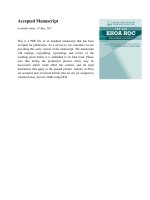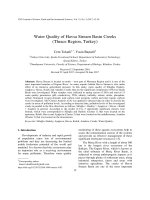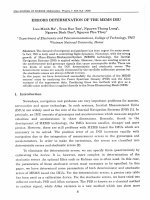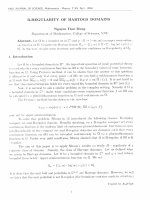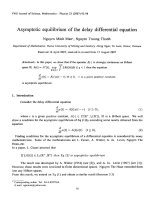DSpace at VNU: Laser-Induced Synthesis of Au-Ag Alloy Nanoparticles in Polyvinylpyrrolidone (C6H9NO)(n) Solution
Bạn đang xem bản rút gọn của tài liệu. Xem và tải ngay bản đầy đủ của tài liệu tại đây (1.7 MB, 13 trang )
J Clust Sci
DOI 10.1007/s10876-015-0877-7
ORIGINAL PAPER
Laser-Induced Synthesis of Au–Ag Alloy Nanoparticles
in Polyvinylpyrrolidone (C6H9NO)n Solution
The Binh Nguyen1 • Thanh Dinh Nguyen1 •
Trong Duc Tran1 • Thu Hanh Nguyen Thi1
Received: 30 December 2014
Ó Springer Science+Business Media New York 2015
Abstract Au–Ag alloy nanoparticles (NPs) were prepared in Polyvinylpyrrolidone
(C6H9NO)n (PVP) solution by laser irradiation method. Au and Ag NPs were
separately prepared in PVP solution by laser ablation. The mixture of Au and Ag NP
colloids was irradiated by the second harmonic (532 nm) of pulsed Nd:YAG laser
with different laser fluencies and exposure times. The Plasmon resonance absorption
spectrum, morphology and structure of Au–Ag alloy NPs were observed by a UV2450 spectrometer (Shimadzu), a high resolution transmission electron microscope
(TEM Tecnai G2 20 S-TWIN/FEI). The results show that the resulting Au–Ag alloy
NPs are homogeneous alloyed particles and dispersed in PVP solution with average
diameter of 4 nm without sintered structure. Au–Ag alloy NPs were produced by
532 nm laser with different Au/Ag molar ratio of the initial mixed solution to give
the plasmon resonance absorption peak in the intermediate positions between about
420 and 520 nm.
Keywords
Au–Ag alloy NPs Á Laser ablation Á Laser-induced synthesis
Introduction
Bimetallic nanoparticles (NPs) have received enormous attention for many years
due to their composition-dependent optical and catalytic properties. Au–Ag
bimetallic NPs are attractive materials because of their fascinating localized surface
plasmon resonance absorption (LSPR) in the visible spectral region. Combination of
desirable features of Ag, Au NPs and Au–Ag bimetallic NPs is useful to a diverse
range of applications related to photonics, catalysis, information storage, chemical/
& The Binh Nguyen
1
Department of Physics, University of Science, VNUHN, Hanoi, Vietnam
123
T. B. Nguyen et al.
biological sensing, and surface-enhanced Raman scattering (SERS) [1–4]. In Au–
Ag bimetallic systems, alloy and core–shell NPs often show different optical
properties, although the composition of Au and Ag within the nanostructures is the
same [5, 6]. The surface plasmon resonance (SPR) absorption peaks, in
consequences, the optical properties of core–shell NPs depend critically on the
relative composition and thickness of the core and shell [7, 8]. Meanwhile, the SPR
absorption peaks of the alloy NPs depend crucially on relative composition of
nanoalloys.
So far, several methods and combination techniques have been developed to
synthesis metal alloy NPs such as biological [9, 10], chemical [11, 12] and laserbased method [13–17]. Chemical syntheses of homogenous alloy NPs of noble
metals require high temperature above 100 °C. Beside this, aqueous co-reduction
methods lead to phase separation [18]. In contrast, laser-based method allows
synthesis of alloy NPs with totally homogeneous structure in aqueous media at room
temperature without reducing agents or organic ligands. The laser-based Au–Ag
alloy NP synthesis has been successfully produced by post-irradiation (laser induced
synthesis) of Ag and Au NP colloids generated during pulsed laser ablation in
liquids (PLAL), by PLAL of Ag or Au bulk targets in Au or Ag NP colloidal
solutions or by PLAL of bulk alloy targets [18]. Post-irradiation of a colloidal
mixture of previously generated Ag- and Au-NPs is an extensively studied method
to prepare Au–Ag alloy NPs. Though there are many reports in literature, to date,
the dominant alloy formation process during laser-induced Au–Ag alloy NP
synthesis is not fully understood. [18]. Depending on the pulse length, the laser
wavelength, laser fluence fragmentation of the NPs and subsequent sintering,
melting and diffusion processes are discussed to elucidate the formation of
bimetallic NPs [19].Compagnini et al. proposed that re-irradiation first leads to
core–shell NPs, later (t [ 10 min) succeeded by alloy NP formation [20] Another
study showed that post-irradiation of a colloidal mixture of Au and Ag resulted in
alloy NP formation after 25 min [21]. For a colloidal mixture of Au and Ag NPs
exposed to laser irradiation, the absorption spectra change as the irradiation time is
increased. They expect that the Au and Ag SPR absorption peaks will disappear and
a new SPR absorption peak located at an intermediate position between the Au and
Ag SPR peaks will be observed due to the formation of Au–Ag alloy NPs. Peng
et al. observed that elimination of the Ag SPR band needs very long irradiation
times when a mixture of Au and Ag NPs (molar ratio 1:1) was irradiated by a
532 nm laser [15]. Even in a laser irradiation times of 30 min, the Ag SPR
absorption intensity (at 406 nm) increases without obvious spectral shift and an
absorption shoulder appeared at 460 nm. They supposed that alloy NPs may be
obtained by two modes: (i) formation of alloy NPs with a larger size or a sintered
structure, and (ii) explosion into smaller alloy NPs depending on the energy
absorbed by the NPs. Both two modes were observed in that report. Morphology,
size distribution of PNs prepared by laser-based method depend on several factors
such as laser wavelength, pulse duration, energy per pulse, irradiation time, liquid
environments and composition of initial mixture in case of laser induced synthesis.
Laser ablation and laser induced synthesis methods depend on several factors
such as laser wavelength, pulse duration, energy per pulse, irradiation time, liquid
123
Laser-Induced Synthesis of Au–Ag Alloy Nanoparticles…
environments and composition of initial mixture in case of laser induced synthesis.
They expected such parameters can be used to control the shape and size
distribution of the NPs [22]. However, variations of the laser parameters during
synthesis alone are not suitable for the size control during PLAL. One characteristic
feature of PLAL method is to give a dispersed size distribution (2–400 nm) [16,
17].The possible strategy for size control may be post-processing of the laserfabricated NPs such as centrifugation at varying speed, yielding different size
fractions [23] or re-irradiation with pulsed lasers, namely pulsed laser fragmentation
in liquid (PLFL) [24].
In this paper we report some results in our study to prepare Au–Ag alloy NPs in
PVP solution by a laser based method where Au and Ag NPs are prepared by PLAL
and then the mixture of Au and Ag NPs is irradiated by a 532 nm laser. The
preparation regime of Au and Ag NPs in PVP by PLAL was studied by ourselves
and reported elsewhere. Laser fluence, laser exposure time and PVP concentration
in water were chosen so that Au NPs can get smaller size than Ag NPs. The
composition of Au and Ag within the nanostructures and accordingly the SPR
absorption peak of Au–Ag alloy NPs can be varied depending molar ratio of Au and
Ag NPs in the initial mixture. The impact of laser fluence and laser irradiation time
on the formation of Au–Ag alloy NPs in PVP was studied and reported. This method
does not need Au–Ag bulk alloys with different compositions which are expensive
to have Au–Ag alloy NPs with any composition. By the laser based method we can
prepare metal alloy NPs in aqueous media at room temperature without reducing
agents or chemical additives.
Experimental
A pulsed Nd:YAG (Quanta Ray Pro 230-Spectra Physics USA) was used to prepare
both Au, Ag NPs and Au–Ag alloy NPs. Au and Ag NPs were separately prepared
by laser ablation of corresponding metal plates (purity of 99.99 %), which was
placed in the glass vessel filled with 10 mL of 0.02 M PVP solution in water. The
laser ablation was performed by laser pulses of 8 ns duration at 10 Hz repetition rate
and 1064 nm wavelength. The laser beam was focused by a lens with a focal length
of 100 mm. The mixtures of the Ag and Au NPs colloidal solutions with different
molar ratios were irradiated by laser beam at 532 nm wavelength. The absorption
spectra of colloidal solutions were recorded by a UV-2450 spectrometer (Shimadzu)
in the 300–800 nm range.
The morphology of the Au and Ag NPs and their alloys was studied by TEM
observation. The HR-TEM images and energy-dispersive X-ray (EDX) spectra were
obtained using a transmission electron microscope (TEM Tecnai G2 20 S-TWIN/
FEI; EXD Genesis XM2, EDAX). The structure of materials was examined by a
X-ray diffraction (XRD) instrument D5005, Bruker, using CuKa radiation
˚ ). The metal concentration of NP colloids was determined by
(k = 1.540656 A
F-AAS technique using a Perkin Elmer AAS-3300 atomic absorption spectroscopy
system. The average laser power was measured by a 13 PEM 001 (Melles Griot)
power meter.
123
T. B. Nguyen et al.
The size of NPs was determined by ImageJ 1.46r of Wayne Rasband (National
institutes of Heath, USA). The size distribution was obtained by measuring the
diameter of more than 500 particles and using Origin 8.5.1 software.
Results and Discussion
Preparation of Au and Ag NPs by Laser Ablation
Gold and silver were separately ablated in 0.02 M PVP solution by 1064 nm
fundamental wavelength of the Nd:YAG laser with average laser power density of
16 W/cm2 and exposure time of 15 min for gold and 7 min for silver. We take the
longer exposure time for gold to get higher concentration of gold in comparison of
silver. Our AAS measurement shows that the concentrations of Au NPs and Ag NPs
in 0.02 M PVP solution are 112.77 and 42.04 mg/L respectively.
The absorption spectra of Au and Ag NPs in PVP solution are shown in Fig. 1.
The characteristic SPR absorption peaks are at about 521 nm for Au NPs and
401 nm for Ag NPs.
TEM image and size distribution of Au NPs and Ag NPs prepared in PVP
solution are presented in Figs. 2 and 3 respectively. The TEM images show both Au
and Ag NPs are rather spherical in shape. The Au NPs have average diameter of
13 nm with size ranging from 2 to 43 nm. The Ag NPs have average diameter of
34 nm with size ranging from 3 to 110 nm.
The crystalline structure of Au and Ag NPs was examined by XRD measurement.
The XRD pattern of Au and Ag NPs showed 03 peaks at around the same position
2h = 38.1°; 44.4° and 64.4° corresponding to diffraction from the (111), (200) and
(220) planes respectively of a face centered cubic structure. This result was
predictable because of the very similar lattice constants between Au and Ag (Au,
˚ ; Ag, 4.0862 A
˚ ) [25].
4.0786 A
Fig. 1 SPR absorption spectra of Au NPs (a) and Ag NPs (b) in PVP solution
123
Laser-Induced Synthesis of Au–Ag Alloy Nanoparticles…
Fig. 2 TEM image (a) and size distribution (b) of Au NPs prepared in PVP solution
Fig. 3 TEM image (a) and size distribution (b) of Ag NPs prepared in PVP solution
Laser Induced Synthesis of Au–Ag Alloy NPs
A mixture of the Au and Ag NPs in 0.02 M PVP solution was prepared with 1:1
volume ratio and irradiated by 532 nm wavelength of Nd:YAG laser. The average
laser power density was set at 1.6 W/cm2 and the exposure time was 20 min. The
Fig. 4 shows the UV–Vis absorption spectrum of the Au–Ag NPs mixtures before
and after laser irradiation.
Notice that the characteristic SPR absorption peak positions of pure Au NPs and
Ag NPs are shifted in Au–Ag colloidal mixture. The SPR peaks for the Au and Ag
NPs in the mixed solution before laser irradiation located at 516 and 421 nm,
respectively (Fig. 4a). They disappeared in the Au–Ag colloidal mixture after laser
irradiation and only one SPR absorption peak was observed at 488 nm. This result
indicates that the resulting colloid contains Au–Ag bimetallic NPs (core–shell or
alloy structure). The single SPR absorption peak in the intermediate positions
between Au and Ag SPR peaks is not enough convinced evidence for Au–Ag alloy
123
T. B. Nguyen et al.
Fig. 4 The absorption spectrum of the mixed solution of Au and Ag NPs (volume ratio 1:1) before and
after laser irradiation
Fig. 5 The TEM image (a) and the size distribution (b) of Au–Ag bimetallic NPs
structure. Core–shell NPs could also give the similar results depending shell
thickness [26]. We investigated the structure of resulting NPs by HR-TEM
observation.
The TEM image and the size distribution of Au–Ag bimetallic NPs were taken
and shown in Fig. 5.
As can be seen in the Fig. 5, the Au–Ag bimetallic NPs are isolated and dispersed
in PVP solution without sintered structure. Their shape is rather spherical and size
ranges from 2 to 10 nm with average diameter of 4 nm.
123
Laser-Induced Synthesis of Au–Ag Alloy Nanoparticles…
The structure and chemical composition of selected Au–Ag bimetallic NPs was
investigated by HR-TEM image analysis and EDX spectroscopy. The HR-TEM
image of asingle isolated Au–Ag bimetallic NP of 6 nm diameter is given in Fig. 6a.
EDX microanalysis demonstrated that the composition of resulting NPs consists
of Au and Ag. The HR-TEM image (Fig. 6a) indicates that the resulting NP has
crystalline structure as Au–Ag alloy NPs but not core–shell structures. We can
estimate from the HR-TEM image that the lattice plane spacing is 0.24 nm which is
˚ ) of XRD pattern in Fig. 6b.
corresponding to the (111) plane spacing (2.3488 A
Using Scherrer equation we can estimate diameter D of the NP
D¼k
k
;
bcosh
˚ = 1.54056 9 10-10 m; h = 19.1°; b = 1.44° =
where: k = 0.9; k = 1.54056 A
0.025 rad (Fig. 6b). It results that: D = 5.9 nm.
The XRD pattern (Fig. 6b) of the resulting NPs showed 03 peaks corresponding
to diffraction from the (111), (200) and (220) planes respectively of a face centered
cubic structure that is similar with Au and Ag NPs due to the very similar lattice
constants between Au and Ag.
Under irradiation with an intense pulsed laser at 532 nm which is near SPR
absorption peak of Au NPs, the Au NPs in the mixed colloidal solution were excited
and heated to their boiling point. The absorbances for Au and Ag NPs at 532 nm are
0.81 and 0.23, respectively. So upon laser irradiation at 532 nm, Au NPs will be
more efficiently excited than Ag NPs of the same size. However, the melting point
of Ag is lower than Au (Ag: 961.78 °C; Au: 1064.18 °C). It is possible that Ag NPs
with lager size can also be heated to meting point at the same time at 532 nm as Au
Fig. 6 HR-TEM image of a selected Au–Ag bimetallic nanoparticle of 6 nm diameter (a) and XRD
pattern (b)
123
T. B. Nguyen et al.
NPs [27, 28]. These heated Au and Ag NPs may be fragmented into smaller NPs by
releasing atoms and clusters. The hot released atoms and clusters have a strong
tendency to rapidly recombine into Au–Ag alloy particles on a nanosecond time
scale [29]. Also, single atoms or small clusters might diffuse to and aggregate on the
surface of preexisting NPs [30]. Since Au and Ag have almost identical lattice
constants, mixing of the two metals is a thermodynamically favorable process.
Therefore, alloying process may take place easily to form homogeneous Au–Ag
alloy particles (as indicated in Fig. 6a). In the presence of PVP—(C6H9NO)n, the
C=O group of the polymer interacts with metal atoms on the surface of NPs. The
oxygen atoms of C=O group are attached to the metal atoms and create local surface
state that protect metal NPs against growth and aggregation [31]. It explains that the
Au–Ag alloy NPs prepared in PVP solution have small size and disperse in solution
without sintered structure (as indicated in Fig. 5).
The formation process of Au–Ag alloy NPs depends strictly on laser fluence and
laser exposure time. A set of experiments was carried out to determine the influence
of laser fluence and laser exposure time in the preparation of Au–Ag alloy NPs. The
mixture of Au–Ag NPs in 0.02 M PVP solution (volume ratio 1:1) was irradiated by
532 nm laser with different laser fluences (0.8, 1.2 and 1.6 W/cm2) during different
exposure times (10, 20 and 30 min). The SPR absorption spectra of the resulting
colloidal solutions are shown in Figs. 7, 8 and 9.
Before exposure to laser light, two distinct absorbance maxima at 516 and 421 nm,
corresponding to pure Au and Ag SPR peaks, respectively. For solutions exposed to
laser irradiation at 532 nm, the absorption spectra changed. This variation in the
absorption spectra clearly implies changes in the colloidal properties. In laser
exposure time of 10 min, a new single absorption peak only starts to be formed at
492 nm when average laser power density increases up to 1.6 W/cm2.
Fig. 7 The absorption spectra of Au–Ag NP colloidal mixtures irradiated during 10 min by different
average laser power densities of 0.8, 1.2 and 1.6 W/cm2
123
Laser-Induced Synthesis of Au–Ag Alloy Nanoparticles…
Fig. 8 The absorption spectra of Au–Ag NP colloidal mixtures irradiated during 20 min by different
average laser power densities of 0.8, 1.2 and 1.6 W/cm2
Fig. 9 The absorption spectra of Au–Ag NP colloidal mixtures irradiated during 30 min by different
average laser power densities of 0.8, 1.2 and 1.6 W/cm2
In laser exposure time of 20 min, the Au SPR absorption intensity decreases and
shifts to the blue, while the Ag SPR absorption intensity decreases and shifts to the
red when laser fluence increases. Further increasing laser fluence, a new single SPR
absorption peak appears with increasing intensity and slightly shifts from 490 to
123
T. B. Nguyen et al.
488 nm when laser power density increase from 1.2 to 1.6 W/cm2.This SPR peak
can be contributed to the formation of Au–Ag alloy NPs.
In laser exposure time of 30 min, two SPR absorption peaks of pure Au and Ag
NPs disappear, only one new SPR absorption peak is formed at 490 nm with
increasing intensity and slightly shifts to 488 nm when laser power density
increases from 1.2 to 1.6 W/cm2.
Our results support that by using intense laser fluence and Ag NPs of large
enough size Ag NPs can be heated to meting point at the same time at 532 nm as Au
NPs and fragmented into smaller NPs by releasing atoms and clusters. The hot
released atoms and clusters rapidly recombine into Au–Ag alloy NPs on a
nanosecond time scale. According to this explanation, the number of Ag and Au
NPs do not increase and consequently the intensities of Ag and Au SPR peaks
decrease as shown in Figs. 7 and 8. The absorption spectra with two peaks in Figs. 7
and 8 are the sum of Ag NP, Au NP and Au–Ag alloy NP absorption bands. By
further increasing irradiation time or laser fluence, the number of Au–Ag alloy NPs
emerges and only SPR absorption peak of Au–Ag alloy NPs is observed. The
formation of Au–Ag alloy NPs by 532 nm laser in this regime of preparation was
not obtained by two mode as proposed by several reports in literature [15, 20, 21].
In our experiments the elimination of the Ag SPR band and accordingly the
formation of Au–Ag alloy NPs occur after 10 min irradiation by 532 nm laser at
average power density of 1.6 W/cm2.
Using laser power density of 1.6 W/cm2, the SPR absorption band is almost
unchanged when laser exposure time increases from 20 to 30 min. The suitable
values of laser power density and exposure time for Au–Ag alloy NPS preparation
in our experiment are 1.6 W/cm2 and 20 min, respectively.
The SPR absorption peak of Au–Ag alloy NPs can be varied between 421 and
516 nm when changing the molar ratio in the initial mixed solution of Au and Ag
NPs. Figure 10 shows the absorption spectra of mixed solutions of Au and Ag NPs
with initial Au/Ag molar ratio of 2/3 (Fig. 10a) and 3/2 (Fig. 10b), respectively
Fig. 10 The absorption spectra of mixed solutions of Au and Ag NPs with initial Au/Ag molar ratio of
2/3 (a) and 3/2 (b), respectively before and after 532 nm laser irradiation
123
Laser-Induced Synthesis of Au–Ag Alloy Nanoparticles…
before and after 532 nm laser irradiation by the same average power density of
1.6 W/cm2and laser exposure time of 20 min.
The SPR absorption peak of Au–Ag alloy NPs shifts from 488 to 471 nm when
initial Ag/Au molar ratio decreases from 3/2 to 2/3. This result supports that Ag and
Au can be miscible in all proportions to give different SPR absorption peak
wavelengths in the intermediate positions between Au and Ag SPR absorption peaks.
In order to prove the role of PVP solution in water we prepared Au–Ag alloy NPs
in distilled water by the same process. Au and Ag NPs were separately prepared in
distilled water and the mixture of Au and Ag NP colloids was irradiated by 532 nm
laser to produce Au–Ag alloy NPs. The average power density of laser was set at
1.6 W/cm2. Figure 11 shows the absorption spectra of the colloidal Au–Ag mixture
in distilled water with different irradiation times.
With an irradiation time of 15 min, only one SPR absorption peak of Au–Ag alloy
NPs appeared at 448 nm (Fig. 11d). This peak shifted to 458 nm and kept almost
unchanged when laser irradiation time increased from 30 to 45 min (Fig. 11e, f).
TEM image and the size distribution of Au–Ag alloy NPs were given in Fig. 12.
Fig. 11 The absorption spectra of mixed solutions of Au and Ag NPs in distilled water with initial
Au/Ag molar ratio of 2/3 by different irradiation times
Fig. 12 TEM image and size distribution of Au–Ag alloy NPs in distilled water
123
T. B. Nguyen et al.
There are two types of morphology corresponding to formation of isolated
spherical NPs and sintered structure, meanwhile no sintered structure when prepared
in PVP solution. The Au–Ag alloy NPs have diameters ranging from 8.4 to 75.3 nm
and their average diameter is of 29.4 nm that is much greater than Au–Ag alloy NPs
prepared in PVP solution by the same average power density of laser and irradiation
time.
Conclusion
We found that Au–Ag alloy NPs could be easily produced by laser irradiation at
532 nm wavelength. The diameter of Au–Ag alloy NPs synthesized by postirradiation of Ag NPs (3–110 nm diameter) and Au NPs (2–43 nm diameter) in PVP
solution ranges from 2 to 10 nm with average diameter of 4 nm. Formation of
homogeneous alloyed particles was clearly demonstrated by UV–Vis absorption
spectroscopy and HR-TEM and EDX measurements. The Au–Ag alloy NP
formation depends strictly on laser fluence (or average laser power density). By
the laser based method we can prepare Au, Ag NPs and Au–Ag alloy NPs with
different Au/Ag molar ratios. The preparation procedure is simple and versatile with
respect to the kinds of metals and liquids employed. The metal alloy NPs can be
produced in solvents without chemical reagents which is compatible in biological
applications.
Acknowledgments This research was supported by Vietnam National University, Hanoi (VNU-HN) in
the project QGTD 13.03.
References
1.
2.
3.
4.
5.
6.
7.
8.
9.
10.
11.
12.
13.
14.
15.
16.
17.
18.
R. Jha and A. K. Sharma (2009). J. Opt. A 11, 045502.
A. K. Sharma and B. D. Gupta (2006). Nanotechnology 17, 124.
R. A. Alvarez-Puebla and J. P. Bravo-Vasquez (2009). J. Colloid Interface Sci. 333, 237.
E. Hao, S. Y. Li, R. C. Bailey, S. L. Zou, G. C. Schatz, and J. T. Hupp (2004). J. Phys. Chem. B108,
1224.
J. Hodak, A. Henglein, M. Giersig, and G. Hartland (2000). J. Phys. Chem. B104, 11708.
J. Abid, H. Girault, P. Brevet (2001). Chem. Commun. 829.
A. N. Shipway, E. Katz, and I. Willner (2000). ChemPhysChem 1, 18.
L. Rivas, S. Sanchez-Cortes, J. V. Garcia-Ramos, and G. Morcillo (2000). Langmuir 16, 9722.
V. Vadlapudi and D. S. V. G. K. Kaladhar (2014). Middle East J. Sci. Res. 19, (6), 834–842.
G. Zhang, et al. (2013). RSC Adv 3, 1878–1884.
D. Alloyeau, C. Mottet, C. Ricolleau Nanoalloys: Systhesis, Structure and Properties (Springer,
London, 2012). ISBN 978-1-4471-4014-6. />S. Link, Z. L. Wang, and M. A. El-Sayed (1999). J. Phys. Chem. B 103, 3529.
Z. Jin, W. Jessica, D. Stephane, K. Christopher, J. Zygmunt, Y. Jakubek, D. Yves, P. Michael, and
S. Benoit (2003). J. Phys. Chem. B107, 6920–6923.
I. Lee, S.W. Han, K. Kim (2001). Chem. Commun. 1782.
Z. Peng, et al. (2006). J. Phys. Chem. B 110, 2549–2554.
A. Mene´ndez-Manjo´n and S. Barcikowski (2011). Appl. Surf. Sci. 257, 4285–4290. doi:10.1016/j.
apsusc.2010.12.037.
S. Barcikowski et al. (2014). Beilstein J. Nanotechnol. 5, 1523.
A. Neumeister, et al. (2014). Phys. Chem. Chem. Phys. 16, 23671.
123
Laser-Induced Synthesis of Au–Ag Alloy Nanoparticles…
19. F. Calvo Nanoalloys from Fundamentals to Emergent Applications (Elsevier, Burlington, 2013),
p. 39.
20. G. Compagnini, E. Messina, O. Puglisi, R. S. Cataliotti, and V. Nicolosi (2008). Chem. Phys. Lett.
457, 386–390.
21. Y. H. Chen, C.-S. Yeh (2001). Chem. Commun. 371.
22. J. C. Alonso, R. Diamant, P. Castillo, M. C. AcostaGarcia, N. Batina, and E. HaroPoniatowskiet
(2009). Appl. Surf. Sci. 255, 4933.
23. F. Bonaccorso, M. Zerbetto, A. C. Ferrari, and V. Amendola (2013). J. Phys. Chem. C 117,
13217–13229. doi:10.1021/jp400599g.
24. S. Link and M. A. Ei-Sayed (2003). Annu. Rev. Phys. Chem. 54, 331–366. doi:10.1146/annurev.
physchem.54.011002.103759.
25. T. Shibata, B. A. Bunker, Z. Zhang, D. Meisel, C. F. Vardeman, and J. D. Gezelter (2002). J. Am.
Chem. Soc. 124, 11989.
26. T. H. Chang, Y. C. Chang, F. H. Ko, and F. K. Liu (2013). Int. J. Electrochem. Sci. 8, 6889–6899.
27. D. D. Evanoff and G. Chumanov (2004). J. Phys. Chem. B 108, 3957.
28. D. D. Evanoff and G. Chumanov (2005). ChemPhysChem 6, 122.
29. A. Dawson and P. V. Kamat (2001). J. Phys. Chem. B 105, 960.
30. F. Mafune, J. Kohno, Y. Takeda, and T. Kondow (2002). J. Phys. Chem. B106, 8555.
31. T. Tsuji, D. H. Thang, Y. Okazaki, M. Nakanishi, Y. Tsuboi, and M. Tsuji (2008). Appl. Surf. Sci.
254, (16), 5224–5230.
123


